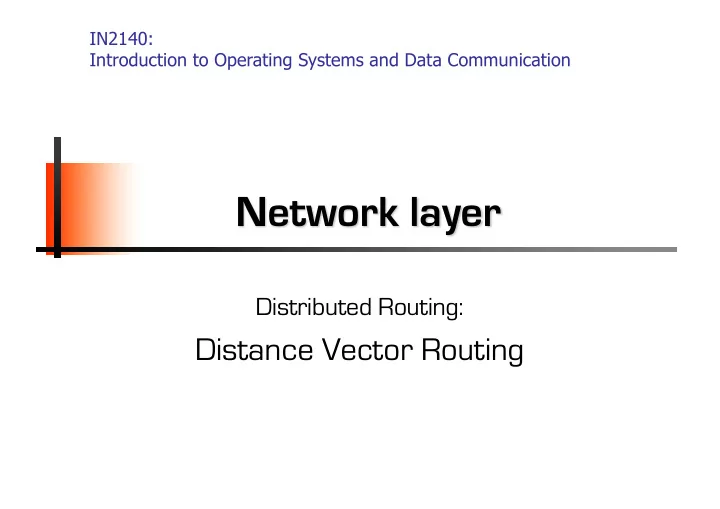

IN2140: Introduction to Operating Systems and Data Communication Network layer Distributed Routing: Distance Vector Routing
Distance Vector Routing Principle § every IS maintains a table (i.e., vector) stating − best known distance to destinations − and line to be used § ISes update tables − by exchanging routing information with their neighbors University of Oslo IN2140 – Introduction to operating systems and data communication
Distance Vector Routing § Each IS − maintains routing table with one entry per router in the subnet − is assumed to know the distances to each neighbor − sends list with estimated distances to each destination periodically to its neighbors § X receives list E(Z) from neighbor Y − Distance X to Y: e − Distance Y to Z: E(Z) − Distance X to Z via Y: E(Z)+e § IS computes new routing table from the received lists containing − Destination IS − Preferred outgoing path − Distance University of Oslo IN2140 – Introduction to operating systems and data communication
Distance Vector Routing A I H K line A B C D A 0 24 20 21 8 A B 12 36 31 28 20 A G C 25 18 19 36 28 I E H D 40 27 8 24 20 H F E 14 7 30 22 17 I F 23 20 19 40 30 I I J K L G 18 31 6 31 18 H H 17 20 0 19 12 H I 21 0 14 22 10 I J 9 11 7 10 0 - K 24 22 22 0 6 K L 29 33 9 9 15 K JA JI JH JK delay 8 10 12 6 § Previous routing table will not be taken into account − Reaction to deteriorations University of Oslo IN2140 – Introduction to operating systems and data communication
Distance Vector Routing § Fast route improvement § Fast distribution of information about new short paths (with few hops) § Example A B C D E − initially A unknown − later: A connected with distance 1 to B, ∞ ∞ ∞ ∞ this will be announced 1 ∞ ∞ ∞ − Distribution proportional to topological spread 1 2 ∞ ∞ 1 2 3 ∞ − Synchronous (stepwise) update is a simplification 1 2 3 4 University of Oslo IN2140 – Introduction to operating systems and data communication
Distance Vector Routing § Slow distribution of information about new long paths (with many hops) § “Count to Infinity” problem of DVR n Example: deterioration A B C D E n Here: connection destroyed 1 2 3 4 n A was previously known, but is now 3 2 3 4 detached 3 4 3 4 n The values are derived from (incorrect) connections of distant IS 5 4 5 6 5 6 5 6 n Comment 7 6 7 6 n Limit "infinite" to a finite value, 7 8 7 8 depending on the metrics, e.g. n ‘infinite’ = maximum path length+1 ∞ ∞ ∞ ∞ University of Oslo IN2140 – Introduction to operating systems and data communication
Distance Vector Routing § Variant: ‘Split Horizon Algorithm’ § Objective: improve the "count to infinity" problem § Principle − In general, to publicize the "distance" to each neighbour − If neighbor Y exists on the reported route, X reports the response "false" to Y distance X (via Y) according to arbitrary i: ¥ • A B C D E 1 2 3 4 Example: deterioration (connection destroyed) n B to C: A = ¥ (real), ∞ 2 3 4 n C to B: A = ¥ (because B is on path to A), ... ∞ ∞ 3 4 ∞ ∞ ∞ 4 But: still poor, depending on topology, example n Connection CD is removed ∞ ∞ ∞ ∞ n A receives "false information" via B n A B receives "false information" via A n Slow distribution (just as before) n C D B University of Oslo IN2140 – Introduction to operating systems and data communication
Recommend
More recommend